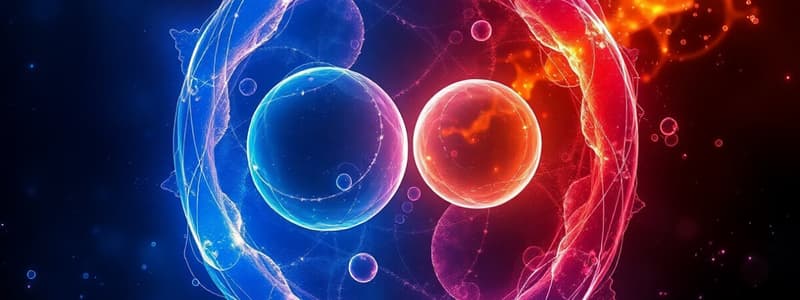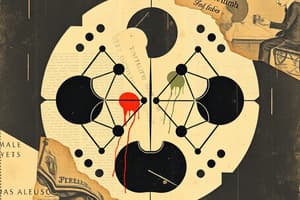Podcast
Questions and Answers
If a cell's cytoplasmic volume increases without a proportional increase in its membrane surface area, which of the following problems would most likely occur?
If a cell's cytoplasmic volume increases without a proportional increase in its membrane surface area, which of the following problems would most likely occur?
- Decreased ability to regulate internal temperature.
- Enhanced structural support and flexibility of the cell.
- Increased efficiency in nutrient uptake and waste elimination.
- Reduced capacity for gas exchange and nutrient absorption. (correct)
During which phase of the cell cycle does DNA replication occur, ensuring that each daughter cell receives a complete set of chromosomes?
During which phase of the cell cycle does DNA replication occur, ensuring that each daughter cell receives a complete set of chromosomes?
- M phase
- G2 phase
- S phase (correct)
- G1 phase
Which of the following best describes the role of proto-oncogenes in a normal cell?
Which of the following best describes the role of proto-oncogenes in a normal cell?
- Inhibiting cell division to prevent uncontrolled growth.
- Repairing damaged DNA to maintain genetic stability.
- Regulating normal cell growth and division. (correct)
- Initiating programmed cell death (apoptosis) when necessary.
How does the process of differentiation contribute to the complexity and functionality of multicellular organisms?
How does the process of differentiation contribute to the complexity and functionality of multicellular organisms?
What is the primary role of tumor suppressor genes in preventing cancer development?
What is the primary role of tumor suppressor genes in preventing cancer development?
If a researcher observes that a cell's chromosomes are highly condensed and the nucleolus is disappearing, which phase of mitosis is the cell most likely in?
If a researcher observes that a cell's chromosomes are highly condensed and the nucleolus is disappearing, which phase of mitosis is the cell most likely in?
During what stage of mitosis are sister chromatids separated and pulled towards opposite poles of the cell?
During what stage of mitosis are sister chromatids separated and pulled towards opposite poles of the cell?
Which event characterizes telophase, the final stage of mitosis?
Which event characterizes telophase, the final stage of mitosis?
What is the primary difference between cytokinesis in animal cells and plant cells?
What is the primary difference between cytokinesis in animal cells and plant cells?
A cell in G0 phase is neither dividing nor preparing to divide. Which of the following cell types are most likely to be in this phase?
A cell in G0 phase is neither dividing nor preparing to divide. Which of the following cell types are most likely to be in this phase?
Flashcards
Differentiation
Differentiation
The process where a cell becomes specialized to perform a specific function.
Cell cycle
Cell cycle
The sequence of phases in the life cycle of a cell, including growth, DNA replication, and division.
Oncogenes
Oncogenes
Genes that can cause cancer when mutated or overexpressed, leading to uncontrolled cell growth and division.
Tumor Suppressor Genes
Tumor Suppressor Genes
Genes that prevent uncontrolled cell growth by repairing DNA, inducing cell cycle arrest, or initiating apoptosis.
Signup and view all the flashcards
Chromatin
Chromatin
The thin fibrous form of DNA and histone proteins.
Signup and view all the flashcards
Sister chromatids
Sister chromatids
Duplicated chromosomes that are attached at the centromere.
Signup and view all the flashcards
Haploid cell
Haploid cell
Cells with half the number of chromosomes (n), such as sperm and egg cells in humans.
Signup and view all the flashcards
Diploid cell
Diploid cell
Cells with a complete set of chromosomes (2n), such as somatic (non-sex) cells in humans.
Signup and view all the flashcards
Metaphase
Metaphase
Chromosomes are aligned at the center of the cell, along the metaphase plate.
Signup and view all the flashcards
Anaphase
Anaphase
Microtubules pull sister chromatids apart to each pole.
Signup and view all the flashcardsStudy Notes
- Mr. Hernandez presents Mitosis in the context of Cell Division
Why Cells Divide
- Cells divide for growth, repair, and reproduction.
- Organisms grow through the addition of cells.
- Multicellular organisms have specialized cells performing different functions which arise through cell division.
- Differentiation is a process through which cells become different.
- Specialized animal cells cannot form an entire organism under normal conditions.
- Plant cells are totipotent and can be developed into a full plant.
- Cell membrane size is the most limiting factor in cell division.
- Cells must obtain nutrients.
- Volume increases more rapidly than the cell surface area.
- Larger cells need a larger surface area to survive.
Cell Cycle
- Cell cycle consists of a sequence of phases in the life of a cell.
- The stages include G1, S, G2, Mitosis, and Cytokinesis.
- The cell "double checks" the duplicated chromosomes for error, making any needed repairs during the G2 phase.
- During the S phase, each of the 46 chromosomes are duplicated by the cell.
- Cellular contents, excluding the chromosomes, are duplicated in the G1 phase.
- Cell cycle arrest occurs during the G0 phase
Cancer Genes
- These drive the uncontrolled growth and cell division leading to cancer when mutated or overexpressed.
- They come from normal genes called proto-oncogenes, which regulate cell growth and division.
Examples of Cancer Genes
- RAS gene family (KRAS, NRAS, HRAS) relates to cell signaling pathways for growth.
- HER2 (ERBB2) relates to a growth factor receptor that pertains to breast cancers.
- MYC represents a transcription factor that promotes cell proliferation.
Tumor Suppressor Genes
- These normally prevent uncontrolled cell growth by repairing DNA
- They can induce cell cycle arrest and initiate apoptosis, also know as programmed cell death.
- Loss or inactivation of tumor suppressor genes can contribute to cancer.
Examples of Tumor Suppressor Genes
- TP53 (p53), also known as the "guardian of the genome," plays a critical role in DNA repair and apoptosis.
- RB1 regulates cell cycle progression.
- BRCA1/BRCA2 is involved in DNA repair; mutations are linked to breast and ovarian cancers.
DNA Repair Genes
- These are responsible for repairing DNA damage.
- Mutations in these genes can lead to genetic instability and increase the risk of cancer.
Examples of DNA Repair Genes
- MLH1, MSH2, MSH6, PMS2 are mismatch repair genes associated with Lynch syndrome, also known as hereditary colorectal cancer.
- ATM is involved in detecting DNA damage and activating repair pathways.
- Cancer arises when mutations accumulate in these genes, disrupting the balance of cell growth and death.
- Mutations may be inherited (germline mutations) or acquired (somatic mutations) because of environmental factors.
- Cancer treatments target specific oncogenes or exploit vulnerabilities in tumor suppressor gene pathways.
Chromosome Anatomy
- A chromosome consists of two identical chromatids.
- One chromatid is an exact copy of the other and each contains one DNA molecule.
- The short arm structure is called the p arm.
- The centromere is the constricted point of the chromosome.
- q arm is the long arm structure.
- DNA molecule is a long string like DNA molecule formed into a compact structure by proteins called histones.
Terminology Associated With Mitosis
- Chromatin is a thin fibrous form of DNA and histone proteins.
- Sister chromatids are identical structures that result from chromosome replication, formed during S phase.
- Haploid cell, are cells with half the number of chromosomes, such as sex cells (sperm and egg).
- Diploid cell are cells with a complete set of chromosomes (one which is paternal and the other maternal), such as somatic cells (non-sex cells).
- In humans, the diploid cell number is 46 and the haploid number is 23.
- A cell cycle includes 2 parts: Growth and Preparation, and then the Cell Division.
- The growth and preparation phase is called interphase, (interphase= G₁ + S + G₂).
- Cell division includes: Mitosis (nuclear division) and Cytokinesis (cytoplasm division).
Interphase
- Interphase occurs before cell division.
- It is the longest part of cycle.
- It has 3 stages: G₁, S, and G₂.
- Daughter cells enter the G1 stage after cytokinesis.
- The cell will grow and multiply organelles and perform many of its specific biochemical functions.
- The G0 phase is the phase in the cell cycle in which the cell is neither dividing nor preparing for division.
- After maturity, nerve and heart cells do not divide again so they stay in the G0 phase.
- DNA replicates during the S, or Synthesis of DNA stage.
- During G2, the cell prepares for mitosis.
- The enzymes needed for cell division are made during G2.
- At the G2 phase, the cell finishes growing.
- During G2, centrosomes appear in the cytoplasm by the nucleus.
- Mitosis begins after G2 and ends before G1
Mitotic Spindle Apparatus Components
- Astral microtubule
- Centrosome with centriole pair
- Kinetochore microtubule
- Polar microtubule
- Sister chromatids
- Poles
Prophase
- During prophase, the nucleolus disappears.
- Chromatin highly condenses into chromosomes.
- The classical chromosome structure appears and becomes visible under a light microscope.
- The nuclear membrane is broken down.
- Microtubules strands or spindle fibers are growing from the centrosome.
- Microtubules strands or spindle fibers attached to a protein structure, also called a kinetochore.
- The kinetochore is located at the centromere of each sister chromatid.
- The mitotic spindle is completely formed.
Metaphase
- During metaphase, chromosomes are aligned at the center of cell.
- They line up along " the metaphase plate."
- Both chromatids face toward opposite poles of the cell and are now ready to be separated.
Anaphase
- During anaphase, microtubules attached to the kinetochore shorten and pull sister chromatids apart to each pole.
- The poles of the cell move farther apart contributing to the separation of the sister chromatids.
- Precise alignment is critical to division.
- At the end of anaphase, the sister chromatids have moved to opposite ends of the cell.
Telophase (Final Phase of Mitosis)
- Chromosomes uncoil back to chromatin.
- Nuclear envelopes form around chromatin in 2 steps.
- Nucleoli reappears in 2 phases.
- The mitotic spindle apparatus is broken up.
- Cytoskeleton forms again.
- Cleavage furrow starting to appear.
- Two new distinctive daughter cells are now visible.
Cytokinesis
- It involves the splitting of the cytoplasm:
- In animals: plasma membrane is pinched off by forming a cleavage furrow.
- In plants: the cell elongates and the cell plate forms out of vesicles (future cell wall and cell membrane).
- Main organelles are replicated (mitochondria, Golgi body and rough endoplasmic reticulum or ER).
- In the end, the cell divides into two genetically identical diploid daughter cells.
Studying That Suits You
Use AI to generate personalized quizzes and flashcards to suit your learning preferences.




